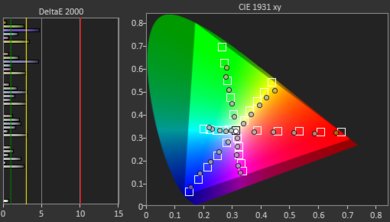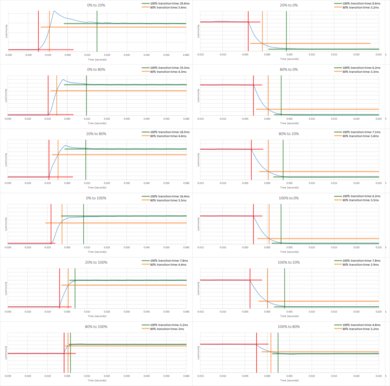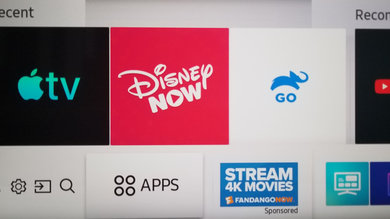The Samsung RU8000 is a decent mid-range 4k TV that delivers good picture quality and solid performance. It delivers deep, uniform blacks, so it's good for dark room viewing, but it lacks local dimming to further improve black levels. It gets fairly bright and has decent reflection handling, although it performs best in dark to moderately-lit rooms. Despite the TV's wide color gamut, HDR content looks okay, but the TV simply doesn't get bright enough to make highlights pop and deliver a satisfying HDR experience. Unfortunately, it has narrow viewing angles, so you have to sit head-on to get an accurate image. On the upside, though, it has an impressive response time, so motion in fast-moving content looks clear, and it has a Black Frame Insertion feature to reduce blur even further. It also has a low input lag and supports FreeSync variable refresh rate (VRR) to reduce screen tearing in games.
Our Verdict
The Samsung RU8000 a decent TV for mixed usage. It can get fairly bright, but it's more suited to a moderately-lit room. It displays deep blacks that look good in the dark, ideal for watching movies, although it lacks local dimming to improve dark room performance. It has a fast response time that makes motion look clear in fast content like sports or video games, and it has a low input lag and VRR support for gaming. HDR looks okay, but the TV doesn't get bright enough to make highlights pop.
- Fast response time.
- Low input lag.
- Fantastic contrast ratio.
- Poor viewing angles.
- Doesn't get bright enough to make HDR content pop.
- No local dimming.
The Samsung RU8000 is decent for watching movies. It has a high native contrast ratio and good black uniformity, and blacks look great in a dark room. Unfortunately, there's no local dimming feature to further improve dark room performance. It can remove judder from any source, but there's a bit of stutter with low frame rate content due to the fast response time.
- Fantastic contrast ratio.
- Excellent black uniformity.
- No local dimming.
- Some stutter with low frame rate content.
The Samsung RU8000 is decent for watching TV shows. It gets fairly bright but may not be suitable for very bright rooms, and while its reflection handling is decent, it's best to avoid placing it directly in front of light sources. It upscales lower resolution content, like cable TV, without issue, but unfortunately, the viewing angles are poor, so the image looks washed out from the side.
- Good gray uniformity.
- Decent SDR peak brightness.
- Poor viewing angles.
- Direct reflections may be distracting.
The Samsung RU8000 is a good TV for watching sports. It gets fairly bright and has decent reflection handling, although direct lights can still be distracting. On the upside, it has a great response time, so fast-moving sports look crisp and smooth. It has good gray uniformity, so dirty screen effect shouldn't be noticeable to most people. Unfortunately, it has poor viewing angles, so it's not the best option for watching with a group in wide seating arrangements.
- Fast response time.
- Good gray uniformity.
- Decent SDR peak brightness.
- Poor viewing angles.
- Direct reflections may be distracting.
The Samsung RU8000 is great for playing video games. It has a quick response time that makes motion look clear in fast-paced games. Its input lag is also low, so gaming feels responsive. It also has extra gaming features like FreeSync VRR and Auto Low Latency Mode. Its high contrast ratio is great for gaming in the dark, but there's no local dimming to improve black levels.
- Fast response time.
- Low input lag.
- FreeSync VRR support.
- Poor viewing angles.
- No local dimming.
The Samsung RU8000 is okay for watching HDR movies. Its contrast ratio is fantastic, and it has excellent black uniformity, resulting in deep blacks. Unfortunately, though, it doesn't have local dimming to improve black levels. Despite having a wide color gamut, it can't deliver a satisfying HDR experience because it doesn't get bright enough to display HDR content as vividly as intended.
- Fantastic contrast ratio.
- Excellent black uniformity.
- Wide color gamut.
- Doesn't get bright enough to make HDR content pop.
- No local dimming.
- Some stutter with low frame rate content.
The Samsung RU8000 delivers a good HDR gaming experience. This is mostly due to its great gaming performance, particularly its low input lag, which stays low even in HDR, and quick response time. Its high contrast ratio produces deep blacks, but there's no local dimming to improve black levels. While it has a wide color gamut, the TV can't deliver a satisfying HDR experience because it doesn't get bright enough to make highlights in HDR pop as they should.
- Fantastic contrast ratio.
- FreeSync VRR support.
- Low input lag and fast response time.
- Doesn't get bright enough to make HDR content pop.
- No local dimming.
The Samsung RU8000 is good for use as a PC monitor. It has a fast response time, and its low input lag ensures a responsive desktop experience. Text looks crisp because it can display proper chroma 4:4:4. Since it's a VA panel, there's also no risk of permanent burn-in from static elements like a desktop interface. Unfortunately, it has narrow viewing angles, so the edges of the screen may look washed out when sitting up close.
- Fast response time.
- Low input lag.
- Displays proper chroma 4:4:4.
- Edges look washed out when sitting close.
- Direct reflections may be distracting.
Changelog
- Updated Feb 17, 2021: Updated review for accuracy and clarity.
- Updated Jul 03, 2020: We have retested the input lag @120Hz in 1080p and 1440p with the latest firmware update (version 1356).
- Updated May 21, 2020: Converted to Test Bench 1.5.
- Updated Feb 21, 2020: Converted to Test Bench 1.4.
Check Price
Differences Between Sizes And Variants
We tested the 55 inch RU8000 (UN55RU8000) version FA01, and we expect our results to be valid for the 65 inch RU8000 (UN65RU8000), the 75 inch RU8000 (UN75RU8000), and the 82 inch RU8000 (UN82RU8000). Most of our results should also be valid for the 49 inch RU8000 (UN49RU8000), but there are some differences that are noted below.
If someone comes across a different type of panel or if their Samsung RU8000 doesn't correspond to our review, let us know and we'll update the review. Note that some tests, like gray uniformity, may vary between individual units.
| Size | US Model | EU Model | UK Model | Costco Variant | Refresh Rate | Notes |
| 49" | UN49RU8000FXZA | UE49RU8005UXXC | UE49RU8000TXXU | N/A | 60Hz | No FreeSync |
| 55" | UN55RU8000FXZA | UE55RU8005UXXC | UE55RU8000TXXU | UN55RU800DFXZA | 120Hz | |
| 65" | UN65RU8000FXZA | UE65RU8005UXXC | UE65RU8000TXXU | UN65RU800DFXZA | 120Hz | |
| 75" | UN75RU8000FXZA | N/A | N/A | UN75RU800DFXZA | 120Hz | |
| 82" | UN82RU8000FXZA | UE82RU8005UXXC | N/A | UN82RU800DFXZA | 120Hz |
The UN55RU8000 we tested was manufactured in February 2019.
Popular TV Comparisons

The Samsung RU8000 is a mid-range TV that performs decently overall. While it doesn't have local dimming like some of its competitors and there may be better TVs for the price, its impressive gaming performance and features like VRR support are welcome on a mid-range TV. For more options, see our recommendations for the best TVs, the best HDR gaming TVs, and the best smart TVs.
The Samsung Q80R is a much better TV than the Samsung RU8000. The Q80R looks and feels much better built, can get much brighter, has better viewing angles, full-array local dimming, and a wider color gamut. On the other hand, the RU8000 has a better contrast ratio.
The Sony X900F is better than the Samsung RU8000. The Sony X900F has a local dimming feature that significantly improves dark room performance. The Sony can get brighter and can handle reflections a little better, so it's more suitable if you have a bright room. The Sony can deliver better HDR performance thanks to the wider color gamut and better HDR peak brightness. The Samsung, on the other hand, is a better TV for gaming, thanks to the lower input lag and the support for FreeSync VRR.
The Samsung AU8000 and the Samsung RU8000 are very similar TVs, with some minor differences. The RU8000 has better contrast and black uniformity, so it’s a bit better for use in a dark room as blacks are a little deeper than on the AU8000. The RU8000 is also the better option for gaming, as it has VRR support, up to 1440p @ 120Hz, and a faster response time for less blur behind quick moving objects.
The Samsung RU8000 and the Samsung Q60T are very similarly performing TVs. The Q60T has a slightly higher contrast ratio and a more accurate picture out of the box, although this can vary between units. The Q60T also gets brighter and has a slightly wider color gamut, delivering a more satisfying HDR experience. That said, the RU8000 is better for gaming since it has VRR support and a much faster response time.

We buy and test dozens of TVs yearly, taking an objective, data-driven approach to deliver results you can trust. Our testing process is complex, with hundreds of individual tests that take over a week to complete. Most of our tests are done with specially designed test patterns that mimic real content, but we also use the same sources you have at home to ensure our results match the real-world experience. We use two main tools for our testing: a Colorimetry Research CR-100 colorimeter and a CR-250 spectroradiometer.
Test Results

The Samsung RU8000 is a 2019 mid-range UHD TV. It replaces the Samsung NU8000 in Samsung's lineup, and it has similar advanced features to those found on the higher-end QLEDs like the Samsung Q60/Q60R QLED or the Samsung Q70/Q70R QLED. Its direct competitors are other mid-range LED TVs like the Sony X900F, the LG SK9500, or the Vizio P Series Quantum 2019.
The Samsung RU8000 has an excellent design. The stand is made of high-quality plastic, supports the TV well, and prevents most wobbling. The back of the TV is plain with a nice texture and resembles the back of the Samsung Q60/Q60R QLED.
The stand is made of good quality plastic and supports the TV well. It's similar to the Samsung Q80/Q80R QLED's stand, but the legs are not hollow to serve as cable guides. The TV wobbles a little if nudged, but it's nothing serious.
Footprint of the 55 inch TV stand: 35.0" x 9.3"
The back of the TV is almost identical to the Samsung Q80/Q80R QLED and other QLEDs from Samsung's 2019 lineup. It's made of plastic and has the typical Samsung textured pattern. There are a few grooves at the bottom that can guide the cables to the legs where a clip helps with the cable management.
Note: We only have one clip, which is unusual, but we're not sure if there were two in the box and we just lost the other one.
The borders are thin and not very noticeable. They are, however, slightly thicker than its predecessor, the Samsung NU8000. We noticed that the lower left corner of the bezel on our unit was cracked, but it did not interfere with our testing.
The TV is slightly thinner than the 2019 QLEDs, but slightly thicker than the Samsung RU7100. If you decide to wall-mount it, you must use the spacers that are included in the box because of the TV's curved back. It shouldn't stick out much.
The build quality feels okay. We did notice a crack in the lower left corner of the bezel, but it didn't interfere with our testing. The TV feels fairly sturdy and you should have no issues with it.
There's no local dimming feature on this TV. The video above is provided for reference only.
Decent SDR peak brightness. It remains fairly consistent when displaying different types of content, except the Peak 2% Window, which is noticeably less bright. This affects the way bright highlights appear across the screen. Overall, the Samsung RU8000 can get bright enough to combat glare in most average-lit rooms.
We measured the peak brightness after calibration, using the 'Movie' Picture Mode and 'Warm 2' Color Tone, with Gamma set to '2.2'.
If you don't care about image accuracy, you can obtain higher brightness levels by adjusting the settings. We were able to reach 396 nits using the 'Movie' Picture Mode and 'Warm 1' Color Tone.
The HDR brightness is sub-par. As with SDR, it remains fairly consistent across different types of content but gets less bright when small highlights flash across the screen. All picture modes and color temperatures had the same max peak brightness.
We measured the peak brightness before calibration, using the 'Movie' Picture Mode and 'Warm 2' Color Tone.
If you don't care as much about image accuracy, you can obtain slightly higher brightness levels. For this TV, however, we were only able to reach a brightness level of 365 nits, using 'Movie' Picture Mode and 'Warm 1' Color Tone, which isn't much brighter than our accurate image brightness.
Good gray uniformity. The edges of the screen are a bit darker, but the rest is fairly uniform, which is good for when there are uniform colors across the screen. Most people shouldn't notice any dirty screen effect, which can be distracting during sports.
This TV has poor viewing angles, as expected from a TV with a VA panel. Even at small angles off-center, gamma shifts and black levels rise, and the image loses accuracy and looks washed out, so this TV isn't the best option if you'll be watching from the side. If viewing angles are an issue, then check out an IPS TV like the LG SK9000.
The Samsung RU8000 has decent reflection handling. Its semi-gloss finish is good with indirect reflections, but it struggles with direct light, so it's best to avoid placing it directly across from bright lighting. If you're looking for a TV with fantastic reflection handling, then check out the Samsung Q90/Q90R QLED.
The Samsung RU8000 has decent out-of-the-box color accuracy. There are inaccuracies that people might notice in shades of gray and in some colors like blue and magenta. The gamma doesn't follow the curve well, and most scenes look a little brighter. The color temperature is a little warmer than the target of 6500K. If you want a similar TV with better color accuracy, check out the Samsung Q60/Q60T QLED.
After calibration, the accuracy is fantastic. The white balance is nearly perfect, and the colors are also greatly improved, but some people might still spot a few inaccuracies in the dark blue and the dark red. The gamma follows the curve very well and the color temperature is almost spot on the 6500K target.
You can see our recommended settings here.
This TV uses a BGR subpixel layout, which can affect how text is rendered. You can read more about that here.
The Samsung RU8000 has a good color gamut, considered wide for HDR content.
The EOTF follows the target quite closely until it rolls off towards the TV's peak brightness, so most scenes overall appear as bright as they should but brighter highlights don't quite pop as intended. In 'Game' mode, the EOTF doesn't follow the stimulus closely, so HDR gaming is slightly dimmer as you can see here.
If you find HDR too dim, check out our recommendations here. With these settings, the RU8000 is noticeably brighter in HDR, as shown in this EOTF.
The color volume on this TV is okay. It can display most dark colors, but like most LED TVs, it has trouble with bright blues. The Samsung NU8000 has a better color volume.
The Samsung RU8000 has good gradient performance. Some fine banding is visible in the dark greens and reds, but it's nothing too serious and hard to notice in normal content. If, however, you find that banding is bothering you, set Digital Clean View to 'Auto' to remove most of it. Unfortunately, this can also cause some loss of fine detail in certain scenes.
There's some very faint image retention immediately after the long exposure of our test image, but it goes away very fast and is hardly noticeable in normal content.
We don't expect VA panels to experience permanent image retention, as the VA panel in our long-term test appears immune.
The Samsung RU8000 uses Pulse Width Modulation to dim its backlight. The flicker frequency is 240Hz in 'Movie' mode but drops to 120Hz in all other modes. It also drops to 120Hz in the 'Movie' mode if you set Auto Motion Plus to either 'Custom' or 'Auto'. This is very similar to what we have seen here on the Samsung Q6FN/Q6/Q6F QLED 2018.
This TV has a Black Frame Insertion feature to help reduce motion blur and make fast-moving objects appear clearer. The BFI feature can lower the flicker frequency to 60Hz. Note that the BFI score is based on the minimum and maximum frequency at which it can operate, not how well it actually performs.
Enabling Auto Motion Plus sets the flicker to 120Hz, and enabling LED Clear Motion reduces the flicker further to 60Hz.
In 'Game' mode, the flicker frequency is always 120Hz. Once again, enabling LED Clear Motion with Game Motion Plus reduces the frequency to 60Hz, making motion look clearer.
The Samsung RU8000 can interpolate lower frame rate content up to 120fps. To enable motion interpolation, you must enable Auto Motion Plus and adjust the available sliders.
See here for more information regarding the settings that control the Samsung RU8000's motion interpolation feature.
Note that just setting Auto Motion Plus to 'Custom' changes the backlight flicker to 120Hz.
Note: The 49 inch model has a 60Hz panel and can only interpolate content to 60fps.
The Samsung RU8000's fast response time makes the image appear to stutter in movies or other lower frame rate content. If stutter bothers you, motion interpolation or the optional Black Frame Insertion feature can help.
This TV can remove judder from all sources.
See our recommended settings on how to remove judder here.
Update 12/17/2019: A flaw was discovered in the way we were testing for G-SYNC compatibility with TVs. We've corrected the flaw, and have retested the 2019 Samsung and LG TVs, and found that the Samsung RU8000 doesn't work properly with NVIDIA's current Adaptive Sync drivers.
The Samsung RU8000 has a native refresh rate of 120Hz. It supports FreeSync variable refresh rate technology for a nearly tear-free gaming experience for those with a compatible AMD card or an Xbox One. The VRR range is excellent, and it's the same at 1080p and at 1440p. At 4k, however, the range is narrower, as the TV only supports resolutions up to 60Hz.
We tested the TV on 'Game' mode, without interpolation or any other gaming processing setting, and we set FreeSync to 'Ultimate' to obtain the widest possible range.
If FreeSync is enabled on a connected device, auto 'Game' mode doesn't work, as the TV simply stays in 'Game' mode.
Note: The 49 inch model has a 60Hz panel and doesn't support FreeSync.
Update 07/03/2020: We have retested the input lag at 120Hz in 1080p and 1440p with the newest firmware update (version 1356). The input lag is 5.9ms for both when in 'Game' mode, and it's no longer skipping frames. The score has been adjusted accordingly.
Excellent low input lag, which most gamers will appreciate. Setting the TV to 'Game' mode results in the lowest input lag at 60Hz. However, when the refresh rate is 120Hz at 1080p and 1440p resolutions on 'Game' mode, the TV skips frames, so we tested the input lag for those resolutions without 'Game' mode, resulting in a higher input lag. Additionally, when the TV is in 'PC' mode, it has the same low input lag as in 'Game' mode, which is great if you're going to use it as a computer monitor.
To find out more about what settings to use to obtain those numbers, and about the Auto Low Latency Mode, see our recommendations settings for Gaming.
Note: The 49" model has a 60Hz panel so it may have a higher input lag.
Update 01/06/2020: We've retested the TV with the latest firmware, and it's now able to display 1080p and 1440p @ 120Hz without skipping frames in PC mode.
The Samsung RU8000 supports most common resolutions, including 1440p @ 60Hz. You have to set the input label to 'PC' in order to display proper chroma 4:4:4. If you want to use your TV as a PC monitor, you may want to check out the Samsung TU8300, which performs almost identically but has a curved screen.
Note: The 49 inch model has a 60Hz panel, and doesn't support 120Hz inputs.
This TV doesn't support DTS audio formats, and it doesn't support eARC, meaning you can't pass an enhanced audio signal to a receiver over HDMI.
Adequate frequency response on the Samsung RU8000. It struggles to produce a really deep bass, but higher frequencies are well-balanced, and dialogue sounds clear. This TV can get loud, but not loud enough for big rooms or loud environments. Unfortunately, it doesn't have a digital room correction to adjust to the room's acoustics.
Mediocre distortion performance. There's a small amount of distortion that increases with volume, but it doesn't get to the point where artifacts are very noticeable. Distortion also depends on the content, and not everyone can hear it.
The TV uses Samsung's Tizen OS, which is intuitive and easy to use.
We didn't run into serious issues during our testing, but the Fit-to-Screen setting doesn't always work. Navigating into the Picture Sizesetting (without changing it) fixes the issue.
Samsung has a large selection of apps in its app store, so you will likely find what you need. The apps on the Samsung RU8000 run well but aren't always smooth.
The remote control is similar to other Samsung remotes. It includes three quick access buttons for Netflix, Hulu, and Amazon Prime Video. It doesn't require line-of-sight and it integrates well with Bixby (Samsung's voice assistant). The remote has a built-in microphone so you can control most of the TV functions with your voice, including launching apps and changing settings, but it's not clear which apps support voice search.
The One Remote feature allows you to control other devices with the remote, even if they don't support HDMI-CEC.















































